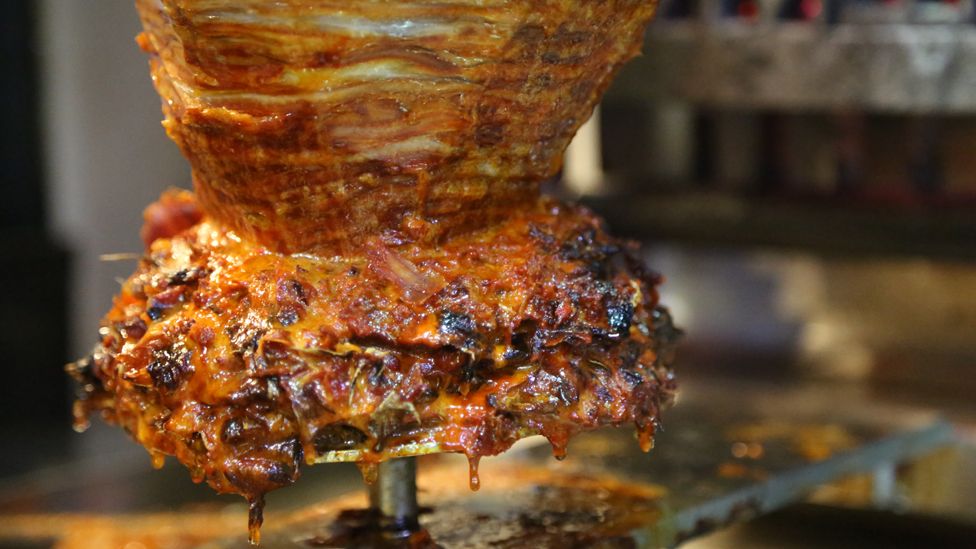Sharwarma: Taco al pastor's culinary ancestor
- Published

Tacos are an intrinsic part of Mexico, but one of its capital city's taco specialties has a Middle Eastern legacy.
The sizzle of meat being cooked on a hot plate is a familiar sound on Mexico City's streets at lunchtime. Workers head to stalls on the side of the road or to taquerias for their fix of tortillas and tacos.
El Huequito is one of Mexico City's most established taquerias. The name means "little hole" in Spanish - an appropriate name for a diminutive hole in the wall in the middle of a row of shops.
According to owner Marco Antonio Buendia Gonzalez, whose parents opened the shop in 1959, the name has a second meaning, referring to the hole in your stomach that a sneaky taco can fill.
There is a huge vertical spit with a massive chunk of meat that is suspended in front of a flame. Another spit sits behind it. Every so often, the chef turns the spits to ensure the meat is evenly cooked.
At first glance, it resembles a Middle Eastern shawarma or a doner kebab. Here in Mexico though, it is known as a trompo, which means spinning top because the shape of the meat is similar - narrow at the bottom and wider at the top.
This is the basis of the taco al pastor - the shepherd's taco, which is one of Mexico City's signature dishes. Its origins though are anything but Mexican.
"It's a story of migration," says Jeffrey Pilcher, author of Planet Taco: A Global History of Mexico Food.
Migrants from the Middle East started to come to Mexico from the end of the 19th Century. They came in much larger numbers in the early 20th Century when the Ottoman Empire was crumbling.
According to Antonio Trabulse Kaim of the Mexican-Lebanese Cultural Institute, there are as many as 800,000 Lebanese people and their descendants now living in Mexico.
"They brought their culture with them, including their food," says Pilcher. "As they settled and opened restaurants in 1930s they were selling the shawarma and they were calling it tacos arabes - Arab tacos."
Many of these migrants settled in Puebla, a colonial city a couple of hours from the capital. There you can still see these restaurants serving up tacos arabes using what is called Arab bread here - similar to a pita.
Making tacos al pastor in Mexico City's "little hole"
The one difference - and it is a big one - is that now these tacos are made with pork, not lamb. Not something you would ever see in the Middle East.
"They were trying to do shawarma with lamb but here in Mexico we don't eat that meat," says Alejandro Escalante, the author of TACOPEDIA, an encyclopaedia on tacos.
"People didn't like it so they tried it with beef and it didn't work out. Finally pork got on this vertical grill and it turned out to be great."
The meat changed, but Arabic bread was still being used. That eventually evolved too, with traditional corn tortillas being introduced.
In the 1960s, says Pilcher, there was a culinary boom in Mexico City. Trendy restaurants opened up and tacos were a part of that. There was lots of experimentation.
"One of the new tacos that starts to get popular at this time is developed by the second generation of Lebanese Mexicans, the kids of those original migrants who are taking that shawarma technique and then adapting it," says Pilcher.
Using pork instead of lamb and adding a chilli marinade led to the 'taco al pastor.'
El Califa is another of Mexico City's well-known taquerias that specialises in tacos al pastor. According to branch manager Carlos Ceja, key to the pastor is to use a small tortilla.
El Califa serves its tacos with onion, coriander and a slice of pineapple - the traditional way here in Mexico. Nobody has a good answer as to where the pineapple comes from. But it seems that the taco's Middle Eastern origins are largely lost.
"The contribution of 20th century immigrants to Mexico which has been unbelievably strong is just wiped out of Mexican record," says food historian Rachel Laudan, author of Cuisine and Empire. "Most Mexicans now think this is a traditional Mexican dish."
"The US almost goes out of its way to identify immigrant foods as immigrant foods, whereas Mexico they are not recognised as such," says Laudan, adding that Mexico is not alone.
"Most British don't associate fish and chips with Sephardic Jews who are probably the people who introduced fish and chips to England in the late 19th Century," she says.
Back at El Huequito in the centre of town, Marco Antonio Buendia Gonzalez says there is no question about the nationality of his tacos, inherited from his mother's recipe many years ago.
"We've changed this creation from the Middle East, we tropicalised it, we use national ingredients," he says.
"The only thing that is borrowed from them is that we use a spit. But the taco is 100% Mexican."
- Published29 March 2015
- Published16 February 2015
- Published3 September 2014